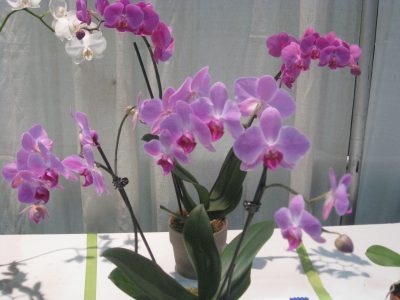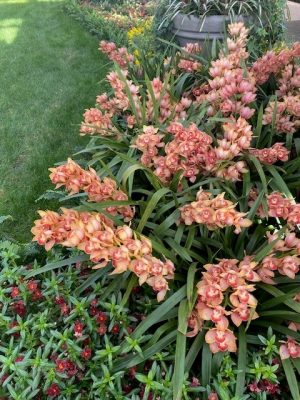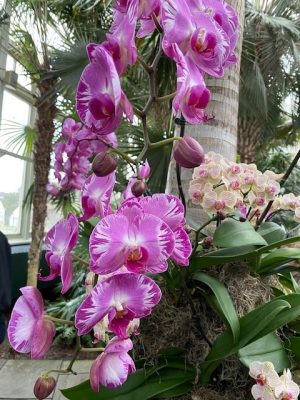By Dawn Pettinelli, UConn Home and Garden Education Center
Some favorite booths at the CT Flower and Garden Show this past weekend were the ones filled with orchids. Orchids are becoming more popular as houseplants and many folks are finding that they can be grown successfully in the home without elaborate care or special equipment. If you’re in a traveling mind, check out the Orchid Exhibit at the New England Botanic Garden in Boylston, MA that runs through March 23, 2025.

Orchids are grouped into two general divisions. Epiphytic orchids naturally grow on trees in the tropics. Trees are used for support. Water and nutrients come from rain, bird droppings and organic debris collecting around the roots. Terrestrial types will grow in a highly organic soil. While epiphytic orchids may tolerate or even enjoy a dry, dormant period, terrestrial species, in general, need to be kept moist throughout the year.
Two styles of growth are exhibited by orchids. Monopodial orchids grow in an upright direction from the central stem on which aerial roots and flowers develop. Sympodial orchids generate new growth from the base of the plant. As the new stems mature and bloom, younger shoots once again are produced and the cycle is continued.
The orchid family is organized into several genera (each called a genus) which may contain from one to many species. Much hybridization has occurred and the names can be baffling to a novice. For instance, hybrids resulting as a cross between Cattleya mossiae and C. warscewiczii are labeled Cattleya x Enid, the ‘x’ indicating the plant is a hybrid.
Some of the easiest orchids for beginners are phalenopsis, paphiopedilum, epidendron, oncidium and cattleya. Not every member of each genera can be successfully grown in the home so be sure to check with your source. Almost all colors are available and blossom size may range from very tiny to several inches in diameter.
The basic requirements for orchids are good ventilation, 40 to 50 percent humidity, light, proper watering and a well-draining potting mix usually composed of fir bark. Often osmunda fiber, tree fern and/or perlite are added to the fir bark.
Specific cultural requirements vary as to the species. Some tolerate higher light levels than others. Many varieties of the orchids listed above prefer 55 to 60 degree F nights and 65 to 68 degree F days although cattlyas, epidendrons and oncidiums like it about 10 degrees warmer. If growing on a windowsill, put the varieties that like it cooler closer to the window. Make sure leaves do not touch the glass.
Ways to increase humidity include grouping plants together, placing on gravel lined trays filled with water, frequent misting or use of a humidifier. Plants should not sit in water and the foliage, if misted, should be dry by evening. Don’t keep plants too close together as good air circulation helps prevent diseases.
Watering is perhaps the trickiest part of growing orchids. There is not accurate rule for when to water because it depends on the size of the container, the type of growing medium, temperature and light conditions. Obviously, plants will have to be watered more often in hot, dry weather and less during cool, damp periods. When watering, soak the potting material thoroughly. Do not water again until the medium feels dry to the touch. If in doubt, do not water.
Since fir bark contains virtually no nutrients, plants have to be fertilized on a regular basis. Some recommend fertilizing at every third watering with a half strength orchid fertilizer. It is best to place plants in the sink and water until it drains from the pot, not putting the plant back in its saucer until it is thoroughly drained. Special orchid pots are available with enlarged drainage holes. Fertilizers should just be applied when plants are actively growing.
Orchids are a plant you have to experiment with but once you’ve experienced success, you will find that as a hobby, they can be quite contagious. Those seeking more orchid information might want to check out the Connecticut Orchid Society (www.ctorchids.org) or the American Orchid Society (www.aos.org).
If you have questions on growing orchids or any home or garden topic, contact the UConn Home and Garden Education Center, toll-free, at 877.486.6271 or visit us at www.homegarden.cahnr.uconn.edu or call your local Cooperative Extension Center.
This article was published in the Hartford Courant Mar. 1, 2025

